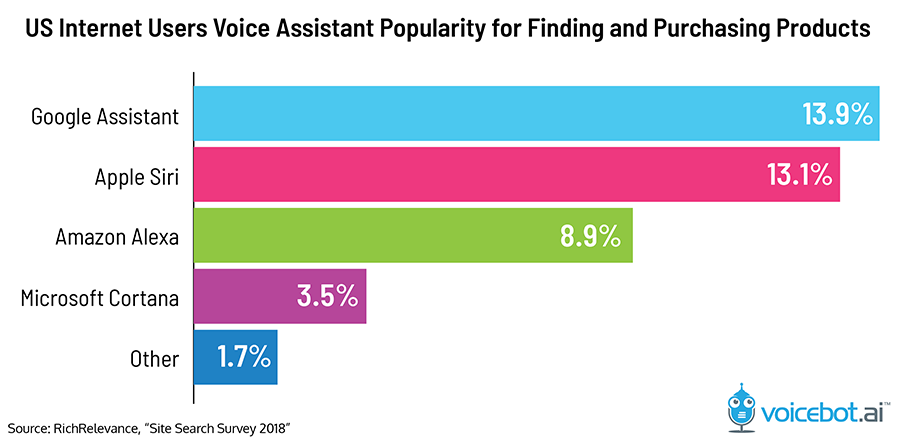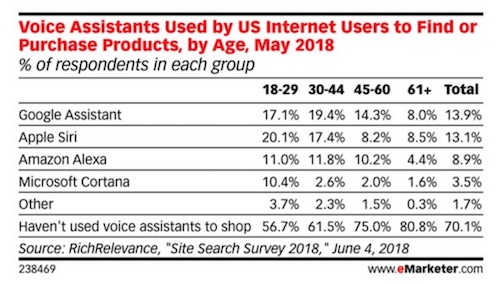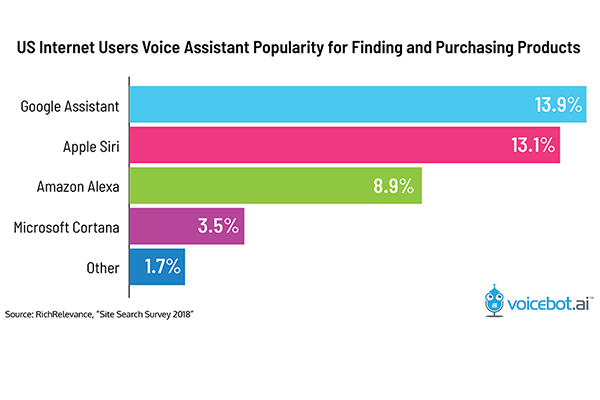Google Assistant Most Used Voice Assistant for Shopping, Outpacing Siri and Alexa
- Google Assistant is the most used voice assistant for shopping processes such as finding products and making purchases at 13.9% of consumers surveyed, but Siri is close behind at 13.1%
- Nearly 30% of internet users have tried using voice assistants to find products or make purchases with the under 45 age group almost twice as likely to use voice as older consumers
- Over one-third of voice shoppers reported having used more than one voice assistant to find products or make purchases
eMarketer is reporting on new survey data from Rich Relevance that shows Google Assistant with a slight lead over Apple’s Siri of 13.9% to 13.1% for consumer use of voice assistants while shopping. The reigning king of smart speakers, Amazon’s Alexa, was the third most popular at 8.9%. Of course, multiple responses were accepted from consumers and further analysis suggests that 37% of these consumers actually have used more than one voice assistant in their product search and shopping activities.

The appearance of the voice assistants native to the top two selling smartphones reinforces that mobile is a key driver today of voice usage while searching for products or placing purchases. Ryan MacInnis, Director of Marketing for Voysis commented:
Consumers want to use their voice to shop and accomplish daily tasks, and Amazon isn’t the only choice they have.
“Two things are becoming clear: consumers want to use their voice to shop and accomplish daily tasks, and Amazon isn’t the only choice they have. With the increase in market share of Google and Apple, consumers can make better decisions of what voice assistant suits them best.”
Consumers Are Beginning to Use Voice in Shopping Activities
Another notable finding from the Rich Relevance data is that nearly 30% of consumers have used voice in a shopping process. Much of this is likely voice search for product information as opposed to consummating a purchase, but consumer habits forming around using voice to search won’t end with product consideration if the transaction step is also easy and reliable.

We are seeing this today where 11.5% of smart speaker owners report using voice shopping on a monthly basis. That is 44% of people that have tried making a purchase through a smart speaker that turned the activity into a monthly habit. Once people try shopping by voice, it is highly likely that they will continue to do so.
The key hurdle to get over is consumer suspicion that voice assistants will not execute shopping processes accurately. eMarketer reports that 63.3% of consumers “polled by RichRelevance said they don’t trust any of the voice assistants currently on the market to get voice-assisted shopping right.” Product search and comparison are low stakes since there is no monetary transaction. Voice assistants are being used today for these “path-to-purchase” steps. The next step is to put processes in place that make it easy for consumers to complete purchases and enhance their confidence in voice as a purchasing channel and not just a shopping channel.
Voice Shopping Skews Younger
Rich Relevance data also shows that voice shopping activity is higher among younger demographics. The 18-29 demographic was more than twice as likely than the 61+ age group to have used voice to find or purchase products. In fact, we see an under and over 45 split where 39-43% of the former have used voice in a shopping process whereas only 19-25% had in the older group.

Brian Roemmele of VoiceFirst.Expert was not surprised by the youth movement toward voice, but did note that the older cohort usage is actually outpacing expectations.
“This study confirms many things I have observed. I think the growth of voice commerce has and will continue to surprise many. The youngest cohort is already fully accustomed to making simple and even somewhat complex purchases using Voice. Part of the surprise is the oldest cohort, 65 and above, have discovered voice commerce and we will begin to see a rapid rise. Of course this is not voice only, we will still need images and video at times but a lot less than most realize.”
Voicebot.ai in collaboration with Voysis will be publishing a report on U.S. consumer attitudes and behaviors related to voice shopping later in June 2018. To pre-register for the voice shopping report, please click the button below.
U.S. Smart Speaker Market Share: Apple Debuts at 4.1%, Amazon Falls 10 Points and Google Rises
Voice Shopping is Monthly Habit for 11.5% of Smart Speaker Owners
Voice Shopping to Reach $40 Billion in U.S. and $5 Billion in UK by 2022









